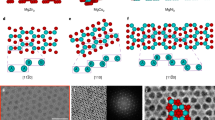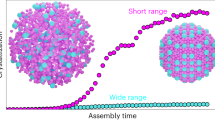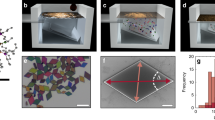Abstract
The assembly of uniform nanocrystal building blocks into well ordered superstructures is a fundamental strategy for the generation of meso- and macroscale metamaterials with emergent nanoscopic functionalities1,2,3,4,5,6,7,8,9,10. The packing of spherical nanocrystals, which frequently adopt dense, face-centred-cubic or hexagonal-close-packed arrangements at thermodynamic equilibrium, has been much more widely studied than that of non-spherical, polyhedral nanocrystals, despite the fact that the latter have intriguing anisotropic properties resulting from the shapes of the building blocks11,12,13. Here we report the packing of truncated tetrahedral quantum dot nanocrystals into three distinct superstructures—one-dimensional chiral tetrahelices, two-dimensional quasicrystal-approximant superlattices and three-dimensional cluster-based body-centred-cubic single supercrystals—by controlling the assembly conditions. Using techniques in real and reciprocal spaces, we successfully characterized the superstructures from their nanocrystal translational orderings down to the atomic-orientation alignments of individual quantum dots. Our packing models showed that formation of the nanocrystal superstructures is dominated by the selective facet-to-facet contact induced by the anisotropic patchiness of the tetrahedra. This study provides information about the packing of non-spherical nanocrystals into complex superstructures, and may enhance the potential of self-assembled nanocrystal metamaterials in practical applications.
This is a preview of subscription content, access via your institution
Access options
Access Nature and 54 other Nature Portfolio journals
Get Nature+, our best-value online-access subscription
$29.99 / 30 days
cancel any time
Subscribe to this journal
Receive 51 print issues and online access
$199.00 per year
only $3.90 per issue
Buy this article
- Purchase on Springer Link
- Instant access to full article PDF
Prices may be subject to local taxes which are calculated during checkout



Similar content being viewed by others
Data availability
The data supporting the findings of this study are available from the corresponding author upon reasonable request.
References
Boles, M. A., Engel, M. & Talapin, D. V. Self-assembly of colloidal nanocrystals: from intricate structures to functional materials. Chem. Rev. 116, 11220–11289 (2016).
Feng, W. et al. Assembly of mesoscale helices with near-unity enantiomeric excess and light-matter interactions for chiral semiconductors. Sci. Adv. 3, e1601159 (2017).
Dong, A. G. et al. Binary nanocrystal superlattice membranes self-assembled at the liquid–air interface. Nature 466, 474–477 (2010).
Lin, H. X. et al. Clathrate colloidal crystals. Science 355, 931–935 (2017).
Wu, L. H. et al. High-temperature crystallization of nanocrystals into three-dimensional superlattices. Nature 548, 197–201 (2017).
Boneschanscher, M. P. et al. Long-range orientation and atomic attachment of nanocrystals in 2D honeycomb superlattices. Science 344, 1377–1380 (2014).
Liu, W. Y. et al. Diamond family of nanoparticle superlattices. Science 351, 582–586 (2016).
Weidman, M. C., Smilgies, D. M. & Tisdale, W. A. Kinetics of the self-assembly of nanocrystal superlattices measured by real-time in situ X-ray scattering. Nat. Mater. 15, 775–781 (2016).
Wang, T. et al. Self-assembled colloidal superparticles from nanorods. Science 338, 358–363 (2012).
Cabane, B. et al. Hiding in plain view: Colloidal self-assembly from polydisperse populations. Phys. Rev. Lett. 116, 208001 (2016).
Haji-Akbari, A. et al. Disordered, quasicrystalline and crystalline phases of densely packed tetrahedra. Nature 462, 773–777 (2009).
Gong, J. X. et al. Shape-dependent ordering of gold nanocrystals into large-scale superlattices. Nat. Commun. 8, 14038 (2017).
Li, R. et al. Competing interactions between various entropic forces toward assembly of Pt3Ni octahedra into a body-centered cubic superlattice. Nano Lett. 16, 2792–2799 (2016).
Manoharan, V. N. Colloidal matter: Packing, geometry, and entropy. Science 349, 1253751 (2015).
Petukhov, A., Tuinier, R. & Vroege, G. Entropic patchiness: Effects of colloid shape and depletion. Curr. Opin. Colloid Interface Sci. 30, 54–61 (2017).
Kallus, Y. & Elser, V. Dense-packing crystal structures of physical tetrahedra. Phys. Rev. E 83, 036703 (2011).
Torquato, S. & Jiao, Y. Dense packings of the Platonic and Archimedean solids. Nature 460, 876–879 (2009).
Conway, J. H. & Torquato, S. Packing, tiling, and covering with tetrahedra. Proc. Natl Acad. Sci. USA 103, 10612–10617 (2006).
Chen, E. R., Engel, M. & Glotzer, S. C. Dense crystalline dimer packings of regular tetrahedra. Discrete Comput. Geom. 44, 253–280 (2010).
Yang, M. et al. Self-assembly of nanoparticles into biomimetic capsid-like nanoshells. Nat. Chem. 9, 287–294 (2017).
Huang, M. J. et al. Selective assemblies of giant tetrahedra via precisely controlled positional interactions. Science 348, 424–428 (2015).
Tang, Z., Kotov, N. A. & Giersig, M. Spontaneous organization of single CdTe nanoparticles into luminescent nanowires. Science 297, 237–240 (2002).
Boles, M. A. & Talapin, D. V. Self-assembly of tetrahedral CdSe nanocrystals: effective “patchiness” via anisotropic steric interaction. J. Am. Chem. Soc. 136, 5868–5871 (2014).
Ghosh, S. et al. Pyramid-shaped wurtzite CdSe nanocrystals with inverted polarity. ACS Nano 9, 8537–8546 (2015).
Tan, R. et al. Monodisperse hexagonal pyramidal and bipyramidal wurtzite CdSe–CdS core–shell nanocrystals. Chem. Mater. 29, 4097–4108 (2017).
Förster, S. et al. Order causes secondary Bragg peaks in soft materials. Nat. Mater. 6, 888–893 (2007).
Hahn, T. International tables for crystallography 5th edn, Vol. A, 1–905 (Springer, Dordrecht, 2005).
Wan, Y. et al. Enhanced tribology durability of a self-assembled monolayer of alkylphosphonic acid on a textured copper substrate. Appl. Surf. Sci. 259, 147–152 (2012).
Grzelczak, M., Vermant, J., Furst, E. M. & Liz-Marzan, L. M. Directed self-assembly of nanoparticles. ACS Nano 4, 3591–3605 (2010).
Vaia, R. A., Teukolsky, R. K. & Giannelis, E. P. Interlayer structure and molecular environment of alkylammonium layered silicates. Chem. Mater. 6, 1017–1022 (1994).
Carbone, L. et al. Synthesis and micrometer-scale assembly of colloidal CdSe/CdS nanorods prepared by a seeded growth approach. Nano Lett. 7, 2942–2950 (2007).
Chen, O. et al. Compact high-quality CdSe–CdS core–shell nanocrystals with narrow emission linewidths and suppressed blinking. Nat. Mater. 12, 445–451 (2013).
Talapin, D. V. et al. CdSe and CdSe/CdS nanorod solids. J. Am. Chem. Soc. 126, 12984–12988 (2004).
Acknowledgements
O.C. acknowledges support from the Brown University Startup Fund, the Salomon Award Fund, the IMNI Seed Fund and the UAC grant from the Xerox foundation. The Cornell High Energy Synchrotron Source was supported by the NSF award DMR-1332208. This work was performed, in part, at the Center for Nanoscale Materials, a US Department of Energy Office of Science User Facility, and supported by the US Department of Energy, Office of Science, under contract number DE-AC02-06CH11357. The TEM and SEM measurements were performed at the Electron Microscopy Facility in the Institute for Molecular and Nanoscale Innovation (IMNI) at Brown University.
Reviewer information
Nature thanks J. Fang, A. Petukhov and the other anonymous reviewer(s) for their contribution to the peer review of this work.
Author information
Authors and Affiliations
Contributions
Y.N., R.L., R.T., Z.W. and O.C. conceived and designed the experiments. R.T. performed nanocrystal synthesis. Y.N. and R.T. conducted TTQD superstructure formations. R.L. and Z.W. carried out the rotational SAXS and WAXS measurements. Y.N., D.E., Y.A.W. and Y.L. performed the electron microscopy measurements. Y.N., H.Z. and R.L. conducted the data analysis and simulation. O.C. supervised the entire project. Y.N. and O.C. wrote the manuscript. All authors discussed the results and commented on the manuscript.
Corresponding author
Ethics declarations
Competing interests
The authors declare no competing interests.
Additional information
Publisher’s note: Springer Nature remains neutral with regard to jurisdictional claims in published maps and institutional affiliations.
Extended data figures and tables
Extended Data Fig. 1 HAADF–STEM images.
a–c, HAADF–STEM images of TTQDs at low (a) and high (b, c) magnification.
Extended Data Fig. 2 Tetrahelix with a left-handed (counter-clockwise) spiral.
a, HR-TEM image of a tetrahelical assembly. b, FFT patterns corresponding to the four consecutive domains. c, The corresponding simulated electron diffraction patterns of the four domains. d, The corresponding schematic illustration of the tetrahelix.
Extended Data Fig. 3 Representative SAXS patterns from different projections obtained from rotational SAXS measurements along the [110]bcc axis.
a–c, [001]bcc projection (a), [\(\bar{1}11\)]bcc projection (b) and [\(\bar{1}10\)]bcc projection (c). The d-spacings of representative spots are labelled.
Extended Data Fig. 4 Construction of a cluster-unit building block of the bcc-supercrystal solid from 36 TTQDs.
a, Wigner-Seitz (W–S) cell of a bcc crystal structure. b, Schematic illustrations of the assembled and disassembled ‘ball-like’ cluster-units comprising 36 TTQDs, viewed from the side and the top. We note that ‘bcc’ represents another level of ‘cluster-based bcc superlattice’, and if a less dense and open structure is considered, a slight symmetry-breaking of the cluster does not modify the bcc structure.
Extended Data Fig. 5 Simulations of the WAXS patterns obtained from the rotational WAXS measurements along the [110]bcc axis.
a–l, Simulations of the WAXS patterns for the [001]bcc projection (a–d), the [\(\bar{1}11\)]bcc projection (e–h) and the [\(\bar{1}10\)]bcc projection (i–l). In the cluster unit, six atomic orientations were used which are colour-coded in the computer-generated models. The orientations are classified using grey, red, purple, blue, yellow and green colours in the model (leftmost panels in a, e, i) and in the corresponding simulated patterns for each orientation (right panels in a, e, i). Simulated WAXS patterns were generated by overlapping six orientations (b, f, j). The experimentally observed WAXS patterns (c, g, k) were compared with the resulting simulated patterns (d, h, l).
Extended Data Fig. 6 Comparison between simulations and experimental results using characterization techniques in real and reciprocal spaces.
a, TEM image for the monolayer superlattice of a bcc supercrystal along the [\(\bar{1}10\)]bcc projection. b, The FFT pattern of the image in a. c, SAXS method (ii) simulation of a bcc supercrystal from the [\(\bar{1}10\)]bcc projection (shown in Supplementary Figs. 19 and 20b). d, SAED pattern from the superlattice area of a. e, SAXS pattern of a bcc supercrystal from the [\(\bar{1}10\)]bcc projection. f, WAED pattern from the superlattice area of a. g, WAXS pattern from a bcc supercrystal from the [\(\bar{1}10\)]bcc projection. We note that b–e all exhibited similar patterns in terms of the signals and the intensity profiles, indicating the validity of our approach to the identification of complex structures by iterating real and reciprocal spaces using the FFT of the model and the TEM images, diffraction patterns such as SAED and SAXS, and TEM images.
Extended Data Fig. 7 TEM and SAED of bcc-supercrystal solids with tri-line contrast.
a–h, Additional TEM images for bcc-supercrystal solids (a, c, e, g) and the corresponding SAED patterns (b, d, f, h). We note that although the TEM images all showed similar patterns with tri-line contrast (a, c, e, g), the SAED patterns for the selected areas gave different patterns (b, d, f, h). This discrepancy is due to a deeper penetration depth of the electron beam used in the SAED measurement than for the 2D TEM imaging. This result indicates that these bcc supercrystals have a three-layer structure, and that the out-of-plane direction is parallel to the [110]bcc direction. We also assigned SAED patterns to the corresponding projections: the [111]bcc projection (b) and the [100]bcc projection (d). The SAED patterns shown here were obtained from a bcc supercrystal without fixed rotational orientations; therefore, some of the SAED patterns did not have clear bcc-oriented patterns such as those in f and h.
Extended Data Fig. 8 TEM tilting experiment with monolayer superlattices of a bcc-supercrystal solid.
a–c, TEM images from [\(\bar{1}10\)]bcc (a), [\(\bar{1}11\)]bcc (b) and \(\left[010\right]\)bcc (c) projections. d–i, The corresponding FFT patterns from the TEM images shown in a–c. These patterns were assigned to the [\(\bar{1}10\)]bcc (d, g), [\(\bar{1}11\)]bcc (e, h) and [010]bcc (f, i) projections.
Extended Data Fig. 9 FTIR spectra of an amorphous powder sample of the TTQDs and the bcc-supercrystal solid.
In all panels, the spectra of the amorphous powder are shown in red and the bcc-supercrystal solid in blue. a, Full FTIR spectra. b, An expansion in the region of 1,600 cm−1 to 1,350 cm−1, which shows various peaks: a characteristic N–H bend appearing at 1,559 cm−1 (green dotted line); asymmetric and symmetric stretching of the carboxylate group (–COO−) appearing at 1,537 cm−1 and 1,430 cm−1 respectively (red dotted lines); a C–H scissoring bend at 1,458cm−1 and CH3–C–H bending at 1,378 cm−1 (blue dotted lines). The peak separation between asymmetric and symmetric stretching of the carboxylate group (–COO−) is 107 cm−1, which suggests bidentate binding and chelate formation. c, An expansion in the region of 1,300 cm−1 to 900 cm−1, the P–O stretching region of the FTIR spectrum of ODPA molecules. The following peaks are observed: P=O vibration; PO3 symmetric stretches in the range of 1,000 cm−1 to 1,150 cm−1; PO3 asymmetric stretches in the range of 950 cm−1 to 1,030 cm−1. The PO3 asymmetric stretch of the bcc-supercrystal sample is blue-shifted by 51 cm−1 (from 1,029 cm−1 to 978 cm−1) when compared with the amorphous TTQD powder sample. The P=O vibration was also considerably weakened in the bcc-supercrystal sample in comparison to the amorphous TTQD powder sample. Similar changes have been observed previously, for example in ref. 28, indicating a higher packing density of ODPA molecules in a confined state as a result of sandwiching between two atomic planes (that is, two {0002}WZ crystal facets).
Supplementary information
Supplementary Information
This file contains Supplementary Methods, a Supplementary Discussion, Supplementary Figures 1-36, Supplementary Tables 1-17, legends for the Supplementary Videos and Supplementary References.
Video 1
SAXS patterns of the bcc-supercrystal from rotational SAXS measurements along the [110]bcc axis with a step angle of 1º.
Video 2
WAXS patterns of the bcc-supercrystal from rotational WAXS measurements along the [110]bcc axis with a step angle of 1º.
Rights and permissions
About this article
Cite this article
Nagaoka, Y., Tan, R., Li, R. et al. Superstructures generated from truncated tetrahedral quantum dots. Nature 561, 378–382 (2018). https://doi.org/10.1038/s41586-018-0512-5
Received:
Accepted:
Published:
Issue Date:
DOI: https://doi.org/10.1038/s41586-018-0512-5
Keywords
This article is cited by
-
Entropically engineered formation of fivefold and icosahedral twinned clusters of colloidal shapes
Nature Communications (2022)
-
Hierarchically engineered nanostructures from compositionally anisotropic molecular building blocks
Nature Materials (2022)
-
Surface-ligand-induced crystallographic disorder–order transition in oriented attachment for the tuneable assembly of mesocrystals
Nature Communications (2022)
-
The role of organic ligand shell structures in colloidal nanocrystal synthesis
Nature Synthesis (2022)
-
Chiral assemblies of pinwheel superlattices on substrates
Nature (2022)
Comments
By submitting a comment you agree to abide by our Terms and Community Guidelines. If you find something abusive or that does not comply with our terms or guidelines please flag it as inappropriate.



